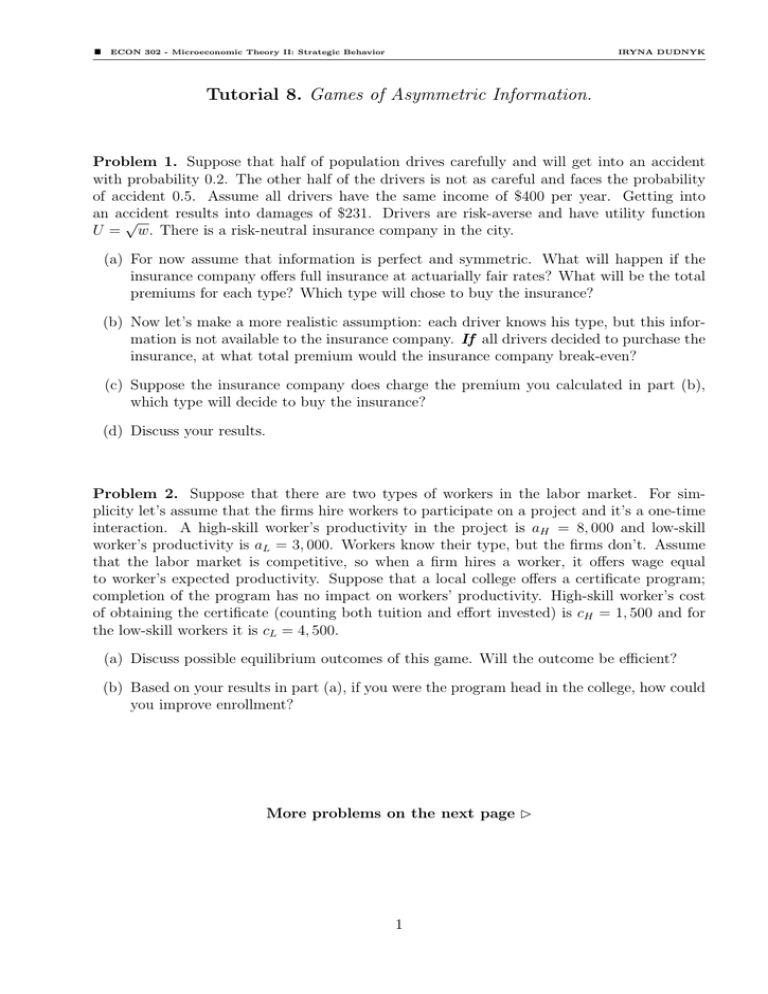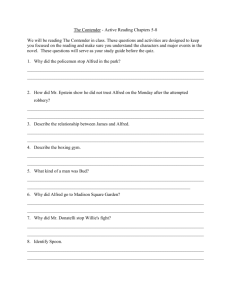Tutorial 8. Games of Asymmetric Information.
advertisement

ECON 302 - Microeconomic Theory II: Strategic Behavior IRYNA DUDNYK Tutorial 8. Games of Asymmetric Information. Problem 1. Suppose that half of population drives carefully and will get into an accident with probability 0.2. The other half of the drivers is not as careful and faces the probability of accident 0.5. Assume all drivers have the same income of $400 per year. Getting into an accident results into damages of $231. Drivers are risk-averse and have utility function √ U = w. There is a risk-neutral insurance company in the city. (a) For now assume that information is perfect and symmetric. What will happen if the insurance company offers full insurance at actuarially fair rates? What will be the total premiums for each type? Which type will chose to buy the insurance? (b) Now let’s make a more realistic assumption: each driver knows his type, but this information is not available to the insurance company. If all drivers decided to purchase the insurance, at what total premium would the insurance company break-even? (c) Suppose the insurance company does charge the premium you calculated in part (b), which type will decide to buy the insurance? (d) Discuss your results. Problem 2. Suppose that there are two types of workers in the labor market. For simplicity let’s assume that the firms hire workers to participate on a project and it’s a one-time interaction. A high-skill worker’s productivity in the project is aH = 8, 000 and low-skill worker’s productivity is aL = 3, 000. Workers know their type, but the firms don’t. Assume that the labor market is competitive, so when a firm hires a worker, it offers wage equal to worker’s expected productivity. Suppose that a local college offers a certificate program; completion of the program has no impact on workers’ productivity. High-skill worker’s cost of obtaining the certificate (counting both tuition and effort invested) is cH = 1, 500 and for the low-skill workers it is cL = 4, 500. (a) Discuss possible equilibrium outcomes of this game. Will the outcome be efficient? (b) Based on your results in part (a), if you were the program head in the college, how could you improve enrollment? More problems on the next page B 1 ECON 302 - Microeconomic Theory II: Strategic Behavior IRYNA DUDNYK Problem 3. Patricia owns a boutique and hired Alfred as a salesperson for her store. For simplicity assume that the daily revenue can be either XH = 60 (in the context of the lecture this means that ‘the project is a success’) or XL = 20 (the project ‘fails’). The revenue depends on two things: demand and Alfred’s effort1 . Alfred can work hard e = 1 or be lazy e = 0. If Alfred works hard the probability of success is 0.8; if Alfred is lazy the probability of success is 0.25. Patricia, who is the principal, is risk-neutral and maximizes her (expected) profits πP = X − w, √ where w is the wage she will pay to Alfred. Alfred (agent) is risk-averse and has payoff πA = w − e (notice that this is his utility of wealth net of the cost of exerting the effort). Instead of working in the boutique Alfred could flip burgers in McDonalds for 16 √ dollars a day which does not involve any effort, so his reservation utility is U = 16 = 4. (a) Suppose that the effort is observable. Find the profit-maximizing wage if (i) Patricia wants Alfred to be lazy (ii) Patricia wants Alfred to work hard. Which level of effort would Particia choose? (b) Now assume that the effort is unobservable. Patricia can no longer make wage contingent on effort, so she realizes that to create incentive for Alfred to work hard she has to give him a bonus in case the sales turn out to be high. Suppose the bonus scheme in this case works as follows: if sales are low, she will pay Alfred wL as you calculated in part (a) for high effort. If sales are high, Alfred will receive wH = wL + B, where B is the bonus. Calculate the lowest bonus that will induce e = 1. Will Patricia choose Alfred to work hard now? Problem 4. Suppose that there are two manufacturers producing a similar product, such that for the consumers the quality of the good is impossible to verify before they actually purchase the product (some electronic device will make a good example). Discuss the potential inefficiency caused by asymmetric information in this case. What solution do markets offer in this case? (Hint: the cost of high-quality product is higher than the cost of producing lowquality good; naturally consumers would be willing to pay higher price for a high-quality good; how can producers of high-quality product distinguish themselves from producers of low-cost product?). 1 This means that when effort is unobservable and the revenue is low, there is no way for Patricia to tell whether the ‘project failed’ because Alfred was lazy or because it was a bad day and the demand was low. 2

